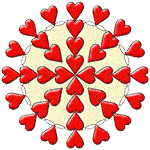

Spend $100 or More & Get 60% off - Use Code BULK60
OR Spend $500 or More & Get 65% off - Use Code BULK65
Spend $1000 or More & Get 70% off - Use Code BULK70
All Sales Final & No Returns. Excludes gift vouchers
By Sonia Acone
When it comes to crystals and minerals, one might reason that the Mohs' scale of Hardness is just that - the hardness of a crystal. However, the Mohs' scale of hardness is rather misleading in its name, as the scale is used to measure how hard a substance is when it is scratched by another substance; in other words, a mineral’s relative resistance to scratching.
Friedrich Mohs, a German mineralogist, devised his scratch-resistance scale back in 1812. However, he was not the first to come up with the idea of hardness in minerals. Pliny the Elder, in 77 A.D. mentioned in his Naturalis Historia, different ways of testing crystals and minerals, one of which was to scratch a mineral with an iron saw, among other things.
According to the Mohs scale, substances are listed from 1-10, with 1 (talc) being the softest and 10 (diamond), the hardest. In this way, other substances may be used to determine the scratch-resistance of different minerals. For example, Calcite has a Mohs hardness of 3 and can be scratched with a knife (hardness of 5.1), but Apatite (hardness of 5) cannot be so easily scratched by the knife.
While the Mohs scale is widely used today, it is not a precise method. One reason for this is that each increment of one in the scale does not reflect a proportional increase in hardness. For example, Calcite (3) to Fluorite (4) reflects an increase in hardness of almost 25 percent; the progression from Corundum (9) to Diamond (10) on the other hand, reflects a hardness increase of more than 300 percent. The exact hardness of a mineral is measured using a sclerometer.
Below is the Mohs' Scale of Hardness:
|
Mineral |
Hardness |
|
Talc |
1 |
|
Gypsum |
2 |
|
Calcite |
3 |
|
Fluorite |
4 |
|
Apatite |
5 |
|
Orthoclase Feldspar |
6 |
|
Quartz |
7 |
|
Topaz |
8 |
|
Corundum |
9 |
|
Diamond |
10 |
Hopefully, this will better inform you of the hardness of crystals so you can better care for them. So if you want to use Malachite in your jewelry, be careful, as it has a Mohs hardness of 3.5, making it too soft to use in rings and such. Crystals such as Amethyst, for instance, might be a better choice, since Amethyst is a type of Quartz and as such, has a hardness of 7. Now you know what all of those numbers are in the Hardness area of the HealingCrystals website!
 hi : it's very informative thanks looking for more thanks (Submitted by: Crystal Amani on June 17, 2014) hi : it's very informative thanks looking for more thanks (Submitted by: Crystal Amani on June 17, 2014) |
| Reply |
| Read more articles like this in the following category: |
| Crystal Reference Library |
FACEBOOK
INSTAGRAM